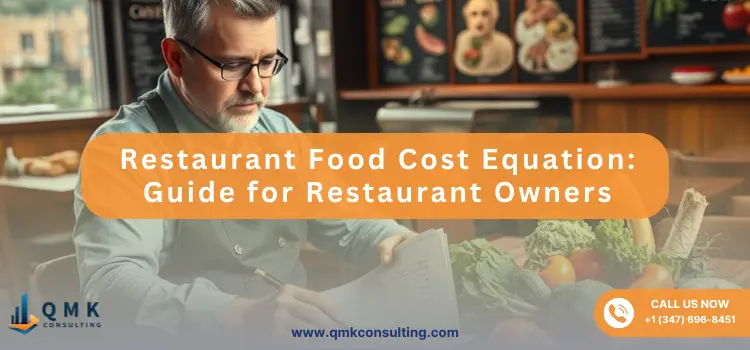
July 3, 2025 |Accounting & Bookkeeping


If you’re running a restaurant, you’ve probably heard the phrase “food cost” tossed around in meetings, budget reviews, or casual chats with your team. But do you truly understand the restaurant food cost equation and why it’s the secret sauce to your profitability? At QMK Consulting, we specialize in franchise accounting and restaurant financials, and we know that mastering food cost isn’t just about cutting corners—it’s about smart, data-driven decisions that protect your margins and fuel growth.
Let’s break down the restaurant food cost equation, why it matters, and how you can optimize it to boost your franchise’s bottom line.
Food cost is one of the biggest expenses in any restaurant, often accounting for about 25% to 35% of total sales depending on the concept. If your food costs are too high, your earnings will quickly decline. Too low, and you risk losing quality or client satisfaction. Striking the right balance is crucial.
For franchise owners, food cost management is even more critical because it impacts royalty fees, franchise compliance, and overall brand reputation. Accurate food cost tracking helps you:
Ignoring food cost is like trying to steer a ship without a compass.
Simply put, the restaurant food cost percentage tells you how much of your food sales revenue is spent on the actual food ingredients. To calculate it, you need to figure out your total food costs during a specific period and then compare that to your total food sales for the same period.
Here’s how you determine your total food costs:
This calculates the total cost of food for that selected time period. Then, you divide that number by your total food sales and multiply by 100 to get your food cost percentage.
Inventory accuracy is the foundation of good food cost management. Many restaurants physically count inventory weekly or monthly to ensure numbers are precise. A perpetual inventory system using software can deliver real-time updates, but physical counts assist identify problems.
Best practices include:
Your purchases should only contain expenses that are directly connected to food items. This means excluding non-food items like cleaning supplies, paper goods, or beverages (unless beverages are tracked separately). Be sure to include complementary items like sauces, garnishes, and condiments that contribute to menu items.
Use net food sales for accuracy—this means total food sales minus any discounts, refunds, or returns. Exclude beverage sales unless you track them separately to avoid skewing your food cost percentage.
If your food costs are rising over industry standards (usually 25-35%), common causes include:
Optimizing food cost isn’t about slashing quality—it’s about efficiency and control. Strategies include:
We worked with a multi-unit franchise restaurant struggling with food costs hovering around 38%. By implementing weekly inventory audits, introducing portion control training, and integrating automated inventory software, they reduced waste and theft significantly. They also updated menu prices based on ingredient costs.
Within six months, their food cost dropped to 32%, improving margins by 6%—translating to tens of thousands in additional profit per location annually.
Technology is your ally in mastering food cost. Popular tools include:
These systems reduce human error, provide real-time insights, and streamline reporting.
Myth: “Lower food cost means higher profit.”
Truth: Lowering quality to save money can harm sales and brand reputation.
Myth: “Food cost is fixed and can’t be changed.”
Truth: With proper management, food cost is flexible and controllable.
Myth: “Inventory counts aren’t that important.”
Truth: Inaccurate inventory leads to misleading food cost percentages and bad decisions.
At QMK Consulting, we help franchise owners build scalable financial models that incorporate accurate food cost tracking, inventory management, and profitability analysis. Based in New York City, we specialize in franchise and restaurant accounting, combining industry expertise with cutting-edge technology.
Our approach is tailored to your unique franchise needs, helping you:
Understanding and optimizing your restaurant food cost equation is the foundation of a profitable franchise. Don't waste money—let QMK Consulting help you spend more wisely and increase your margins.
Book a FREE Profit & Cash Flow Analysis with Mohamed Karmous, franchise accounting expert and restaurant accounting advisor at QMK Consulting. Our experts will analyze your financials, uncover hidden opportunities, and provide a clear roadmap to profitability.
QMK Consulting is your restaurant and franchise accounting firm in New York. Let’s build your financial success together.
Claim your free profit & cash flow analysis today—because every dollar counts.